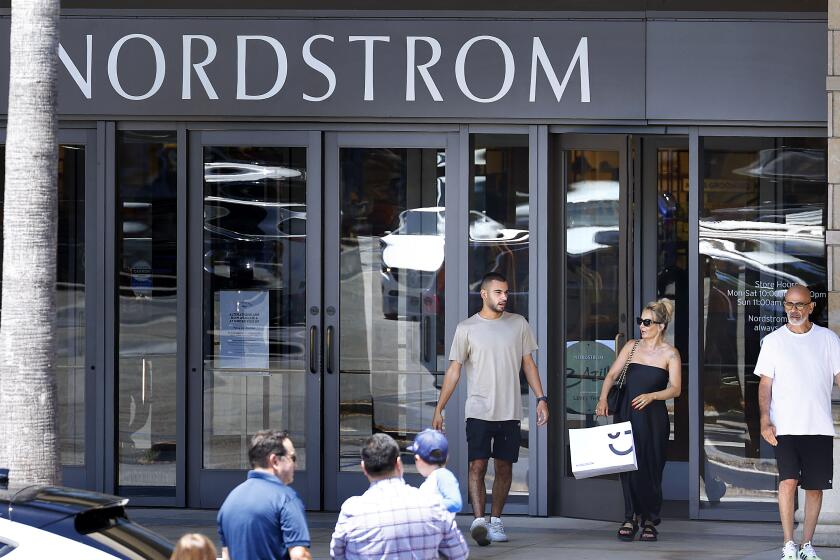Dow Slips 2.50 to 2,331.25 in Seesaw Session : Jobs Report Fuels Fears of Inflation, Quiets Trading
- Share via
NEW YORK — Stock prices were little changed Friday in a indecisive appraisal of stronger-than-expected employment growth at the start of 1989.
The Dow Jones industrial index, which lost about 9 points in the past two sessions, fell another 2.50 points to close at 2,331.25.
For the week, the Dow advanced 8.39 points, compared to an 87.5-point surge the week before.
Advancing issues outnumbered declines by about 6 to 5 in nationwide trading of New York Stock Exchange-listed stocks.
Volume on the floor of the Big Board came to 172.98 million shares, down from 183.43 million in the previous session.
The blue chip index was under pressure from the opening as the Labor Department had just reported that 408,000 jobs were created in January, far above forecasts of less than 300,000.
“This (employment) report has to be acknowledged as not being helpful for the inflation trend in the economy,” said A. C. Moore, director of research at Argus Research Corp.
Higher Interest Rates Expected
“If you look at all the important variables of the data, job growth, average work week, hours, it tells you the economy is growing at a pace well above 3% and does not seem to have slowed down at all,” said Joseph Carson, an economist with Chemical Bank.
Many analysts expect the Federal Reserve to nudge interest rates higher to quell inflationary pressures suggested by the jobs report. Higher rates would raise the costs of business expansion and squeeze corporate profits.
The Dow recovered later in the day but then slipped back again, unable to break out of a tight trading range.
Traders’ fears of higher interest rates apparently were offset to a significant extent by the dollar’s rise in foreign exchange after the report was issued.
A sustained rally by the dollar would stand to attract money from overseas into U.S. investments.
Brokers also said money managers who had been left behind in the market’s recent rally were still engaged in catch-up buying each time stock prices pulled back a bit.
West Point-Pepperell climbed 2 to 55 5/8 in active trading. The company, which is opposing a $52-a-share takeover bid by Farley Inc., said it would solicit offers from others in an effort to get a better price.
Eli Lilly gained 3 to 95 1/2, trading at new 52-week highs. The company reported fourth-quarter earnings of $1.24 a share, up from 96 cents a share in the comparable period a year earlier.
Elsewhere among the blue chips, Philip Morris gained 1/2 to 109, American Telephone & Telegraph rose 1/8 to 32 1/8, International Business Machines dropped 5/8 to 127 3/4 and General Electric lost 1/4 47 7/8.
Some airline issues added to their recent gains. Delta Air Lines rose 3/4 to 57 7/8, AMR gained 2 5/8 to 62 and Pan Am added 1/8 to 3 1/2. But UAL dropped 1/8 to 123 5/8.
The Wilshire index of 5,000 equities closed at 2,921.610, up 3.252 from the Thursday’s close.
The NYSE’s composite index of all its listed common stocks edged up 0.15 to 166.50.
Standard & Poor’s industrial index rose 0.22 to 343.84, and S&P;’s 500-stock composite index was up 0.13 at 296.97.
The NASDAQ composite index for the over-the-counter market gained 1.19 to 406.35, climbing back above its close on the eve of Black Monday Oct. 19, 1987. At the American Stock Exchange, the market-value index closed at 324.88, up 0.36.
In contrast to Wall Street’s dull performance, equities surged in many markets overseas.
Stock prices closed at a record high on the Tokyo Stock Exchange in hefty trading, helped by active buying of construction stocks. The Nikkei 225-share index rose 187.48 points, or 0.60%, to 31,685.78.
The London Stock Exchange closed at a new post-crash closing high. The Financial Times 100-share index closed up 26.5 points at 2,069.9 in London. The index has now gained 15.4% since the start of the year.
More to Read
Inside the business of entertainment
The Wide Shot brings you news, analysis and insights on everything from streaming wars to production — and what it all means for the future.
You may occasionally receive promotional content from the Los Angeles Times.










